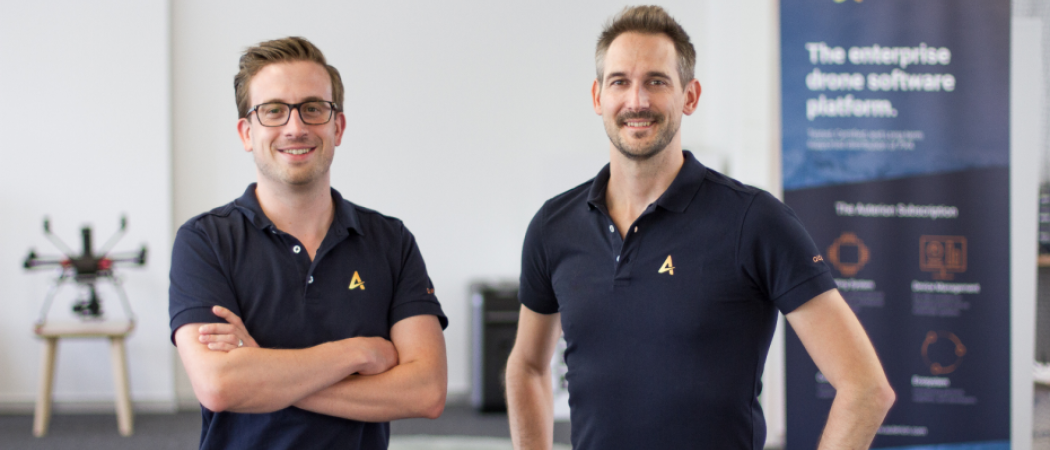
ETH Alumni Lorenz Meier and Kevin Sartori, founders of Auterion (Photograph: Auterion)
Auterion, the world’s largest open-source drone software company, announced 10 million (USD) in seed funding earlier this month. Founded just over a year ago by ETH Zurich Alumni, Lorenz Meier and Kevin Sartori. Auterion’s seed round surpasses the current European average of 1.17 million (Venture Beat1). It even tops the latest Silicon Valley average seed round of 6.3 million (Tech Crunch2). So how has this Swiss start-up attracted some of the world’s top investors? Could Auterion’s success be attributed to just 3 success factors?
A well-timed idea
Goldman Sachs predicts a market demand for commercial drone products and services to grow to $13 billion by 2020, but the industry is still highly fragmented according to Meier. Responding to the call of the market, Auterion recently launched a new open-source operating system that unifies standards and provides a cyber-secure, compliant operating system specifically designed for commercial drone enterprises. The operating system sits on top of the open-source PX4 software that Meier developed 10 years ago as a graduate student in the Computer Vision and Geometry Lab at ETH Zurich.
Today, developers and companies from around the world use PX4. Companies including Intel, Sony, and Yuneec use the open software and hardware to operate consumer and commercial drones. Surprisingly the PX4 computer vision algorithms, autopilot hardware design, communication protocol, and ground station software are available to anyone as an open-source via Github and the Dronecode community, organized as a collaborative project by the Linux Foundation.
Auterion takes PX4 one-step further. Serving the commercial enterprise market, it is the first to create a compatible ecosystem. A cloud solution allows developers to deploy machine learning, computer vision applications, monitor devices, upload data directly to the cloud, as well as, receive technological support. “Every successful open-source ecosystem needs enterprise software vendors to make the work of the community accessible to the industry...,” says Chris Anderson, CEO 3D Robotics.
A balance of talent
Meier and Sartori met about a decade ago in Roland Siegwart’s Autonomous Systems Labat ETH Zurich. While Sartori holds a graduate degree in Robotics from ETH Zurich his path led him to an MBA at UC Berkeley and positions in industry, including a stint in Silicon Valley at 3D Robotics. Meanwhile, Meier completed his doctorate in Drone Software Architecture, also at ETH, and further developed not only PX4 and Pixhawk, but also other UAV protocols.
Meier values collaboration and Sartori’s industry background made their partnership a natural one. Both co-founders believe in really listening to the market. Sartori says, “I have literally climbed telephone poles with inspectors to see if drone technologies can make life in these industries easier and safer.”
“Finding solutions to today’s problems requires global collaboration and deep expertise across many fields. As a world-class institution at the vanguard of science and technology, ETH Zurich is able to bring together talented individuals across diverse sectors. As such, we have found ETH Zurich to be a rich source of innovation. We believe Auterion’s software will be at the forefront of the growing drone and autonomous robot industry,” says Klaus Hommels, Lakestar.
Strategic support
With venture capitalists clamoring for the opportunity to invest at the ground level, Meier and Sartori approached the opportunity strategically. Already a well-established and trusted entity in the open-source community and working with global companies, not to mention, access to ETH Zurich’s talent pool, Auterion presented a limited risk for investors. Meier and Sartori intentionally sought out international investors who focus on developing European technology. They accepted seed round funding from Lakestar, Mosaic Ventures, Costanoa Ventures, and Tectonic Ventures.
Investors, such as Toby Coppel former Executive VP and Chief Strategy Officer at Yahoo!, seem to agree with the team’s solution-oriented approach to technology. "We love to back founders that swing for the fences. We imagine a future in which millions of drones around the globe will be available on-demand to carry out important tasks for businesses and governments. Auterion’s software platform is the leading choice to power all of those drones," says Coppel.
Special acknowledgement
Lorenz Meier acknowledges that his success with PX4, Pixhawk and other UAV protocols such as MAVLink, and QGroundControl would not have been possible without the strong support of open source development by Professor Marc Pollefeys, ETH Zurich’s Computer Vision and Geometry Lab.
This article was first published 18 September 2018 by ETH Zurich.





 A unique international forum for public research organisations and companies to connect their external engagement with strategic interests around their R&D system.
A unique international forum for public research organisations and companies to connect their external engagement with strategic interests around their R&D system.